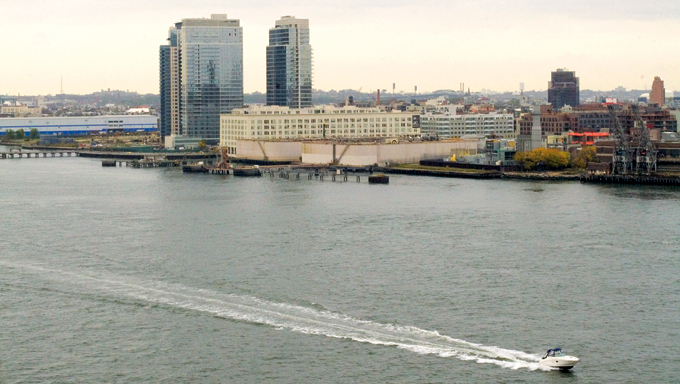Trending
Williamsburg waterfront — prophecy fulfilled?
Five years after rezoning, developers finally start to reap rewards

The Williamsburg waterfront
Five years ago, the possibilities on the Williamsburg waterfront seemed endless to developers following a massive rezoning in the neighborhood in the midst of a bull market. In response, residential developers like Jeffrey Levine and Louis Kestenbaum leapt into projects.
The sentiment was so cheery that Developers Group president and CEO Elan Padeh predicted that, in 2010, residential sales on the waterfront “should easily get $1,000 to $1,100 a square foot.”
It’s easy to see why developers would have felt that way. On a clear day, the waterfront affords a showstopping view of Manhattan, and the only crowds to contend with are flocks of seagulls — a far cry from the louder, trendier Bedford Avenue scene.
Of course, after a fiscal meltdown, the optimism dulled somewhat. “If there’s something we’ve learned in these five years, it’s that prophecy [is for] Nostradamus,” Levine, chairman of Douglaston Development, joked of the post-rezoning waterfront development.
But maybe those predictions from the heady days of 2005 weren’t that far off.
Over the summer, the Edge’s first closed sale hit public record, after sales launched in March 2008, and 2 Northside Piers garnered FHA approval in September. In July, the City Council approved a $1.5 billion, 2,200-unit redevelopment plan for the waterfront’s Domino Sugar factory, after nearly six years of planning for the massive 11-acre site.
Some of Levine’s units at the Edge have sold for as much as $1,200 per square foot, although smaller, less popular units have sold for under $700 per square foot. (“We have milk, and we have cream,” Levine noted.)
And a warehouse along the southern end of the waterfront has been on the market for $100 million. The site was rezoned this year, and plans call for new towers with more than 700 apartments.
To envision the future of the Williamsburg waterfront, The Real Deal looked at some of the up-and-coming (or stuck-in-the-mud) projects.
The Bushwick Inlet Park Parcel
Kent Avenue/Franklin Street between North 15th and North 9th streets
Owners: various
This 28-acre waterfront park was planned in 2005 as a part of the city’s overall rezoning of Williamsburg. Today, much of the park is still in its planning stages, while the Parks Department seeks funding and works out deals (either through eminent domain or negotiation) with the current owners. A soccer field has been built at North 9th Street and Kent Avenue, while the area along 50 Kent Street, which extends from North 12th to North 11th streets, is being cleaned to rid the soil of contamination.
Owner: Robert Beswick
Beswick owns five separate properties along this block of Grand Street. The street has not been as influenced as others have by the waterfront’s evolution from warehouse to penthouse. Beswick’s portfolio includes three buildings and two lots, and he just leased 48 Grand Street to Sprout Home, a plant store headquartered at 44 Grand Street that is expanding. He’s also in talks to lease another storefront at 46 Grand Street to a jewelry store. “The retail thing wasn’t really happening so much” in previous years, Beswick said. “There was really a surprise in the last eight or nine months” as activity picked up.
Owner: 110 Kent LLC, run by Mark Nagawiecki
Although this edifice didn’t fall under the city’s rezoning purview — the three-story, 85-year-old building is slated for industrial use — that apparently didn’t stop the owner from going residential. A former resident told The Real Deal that he — and many other tenants — have lived there recently, and the building’s record with the Department of Buildings confirms as much. The building has received seven Environmental Control Board violations since 2000; six of these violations are still open. The infractions center on the residential transformation, including illegal plumbing work that created apartment bathrooms and occupancy contrary to the certificate of occupancy. The phone number for 110 Kent LLC has been disconnected.
Owner: JMH Development
Although it drummed up its fair share of skepticism when it began leasing in the throes of the recession in February, a representative from the high-end, 340-unit rental building told The Real Deal that 184 Kent is now 85 percent leased. Prices start at $2,850 for a one-bedroom, according to a building spokesperson, but some units have brought home bigger bucks: A handful of larger apartments have been rented for more than $6,000 a month, according to data from StreetEasy. The Cass Gilbert-designed building had been a manufacturing facility prior to its rezoning.
Owner: 240 Kent LLC
Before the recession, this building’s owner had grand plans: According to a March 2006 permit filed with the DOB, the three-story manufacturing building was aiming to grow by seven stories. However, the permit expired in April 2008, and a new certificate of occupancy was never issued. One year later, a new permit to add just one additional story to the building was filed; that permit expired in December.
Developer: L+M Development Partners, with Goldman Sachs’ Urban Investment Group
This once-stalled rental development is back on track, according to L+M’s Lisa Gomez, executive vice president of development, and Spencer Orkus, project manager for L+M. The 160-unit project, which is now set to be 20 percent low-income, 60 percent middle-income, and 20 percent market-rate units, went through several iterations on the way to a relaunch. When first planning the project roughly four years ago, Gomez said the aim was for something more high-end. “The notion was to do a hotel with condos,” she said. The changes were made largely to “mitigate risk and get something financed and built in this market.” Orkus said the development, which is expected to include a supermarket, is on track to be completed in December 2012.




